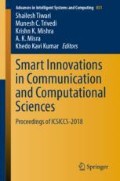Abstract
Graphs have been successfully applied in several applications such as classification of protein molecules or chemical compounds, software bug detection, text classification etc. to model structural relationships in the data. Existing graph classification methods have focused on either graph kernels or frequent subgraph patterns for classification. Graph kernel approaches work with fixed input dimension whereas subgraph feature based methods suffer from exponential pattern search space and high complexity due to graph isomorphism. To overcome these limitations, the proposed approach of classification using maximum connected component (CMCC) builds DFS tree to store only maximum substructures based on DFS canonical code approach of gSpan. Once DFS trees are built for all the classes, the query graph is classified based on its maximum match with input graph set. Advantages of using DFS trees are faster graph matching as compared to graph isomorphism test, less storage requirements and speed-up in execution time. Experimental analysis on five real-world datasets shows that the proposed method CMCC significantly enhances the classification accuracy as compared to other established methods on most of the datasets.
Access this chapter
Tax calculation will be finalised at checkout
Purchases are for personal use only
References
Deshpande, M., Kuromochi, M., Wale, N., Karypis, G.: Frequent substructure-based approaches for classifying chemical compounds. IEEE Trans. Knowl. Data Eng. 17(8), 1036–1050 (2005)
Jin, N., Young, C.: Graph Classification Based on Pattern Co-occurrence. CIKM, Hong Kong, China (2009)
Jin, N., Young, C.: Graph Classification Using Evolutionary Computation. SIGMOD, USA (2010)
Ranu, S., Hoang, M., Singh, A.K.: Mining discriminative subgraphs from global-state networks. In Proceedings of the 19th ACM International Conference on Knowledge Discovery and Data Mining, pp. 509–517 (2013)
Dang, X.H., Singh, A.K., Bogdanov, P., You, H., Hsu, B.: Discriminative subnetworks with regularized spectral learning for global-state network data. In: Joint European Conference on Machine Learning and Knowledge Discovery in Databases, pp. 290–306. Springer, Berlin, Heidelberg (2014)
Dang, X.H., You, H., Bogdanov, P., Singh, A.K.: Learning predictive substructures with regularization for network data. In: IEEE International Conference on Data Mining (ICDM), pp. 81–90 (2015)
Pan, S., Zhu, X., Zhang, C., Philip, S.Y.: Graph stream classification using labeled and unlabeled graphs. In: IEEE 29th International Conference on Data Engineering (ICDE), pp. 398–409 (2013)
Inokuchi, A., Washio, T., Motoda, H.: An apriori-based algorithm for mining frequent substructures from graph data. In: Principles of Data Mining and Knowledge Discovery, pp. 13–23 (2000)
Kuramochi, M., Karypis, G.: Frequent subgraph discovery. In: Proceedings of the IEEE International Conference on Data Mining ICDM, pp. 313–320 (2001)
Huan, J., Wang, W., Prins, J.: Efficient mining of frequent subgraphs in the presence of isomorphism. In: IEEE 3rd International Conference on Data Mining, ICDM, pp. 549–552 (2003)
Yan,X., Han, J.: gspan: graph-based substructure pattern mining. In: Proceedings of the IEEE International Conference on Data Mining, ICDM, pp. 721–724 (2002)
Nijssen, S., Kok, J.N.: A quickstart in frequent structure mining can make a difference. In: Proceedings of the 10th ACM SIGKDD International Conference on Knowledge discovery and data mining, pp. 647–652 (2004)
Schölkopf, B., Tsuda, K., Vert, J.P. (eds.): Kernel Methods in Computational Biology. MIT press (2004)
Mahé, P., Ueda, N., Akutsu, T., Perret, J.L.: Extensions of marginalized graph kernels. In: Proceedings of the 21st ACM International Conference Machine Learning, p. 70 (2004)
Seeland, M., Karwath, A., Kramer, S.: A structural cluster kernel for learning on graphs. In: Proceedings of the 18th ACM SIGKDD International Conference on Knowledge discovery and data mining, pp. 516–524 (2012)
Shervashidze, N., Schweitzer, P., Leeuwen, E.J.V., Mehlhorn, K., Borgwardt, K.M.: Weisfeiler-lehman graph kernels. J. Mach. Learn. Res. 12, 2539–2561 (2011)
Neumann, M., Garnett, R., Bauckhage, C., Kersting, K.: Propagation kernels: efficient graph kernels from propagated information. Mach. Learn. 102(2), 209–245 (2016)
Riesen, K., Bunke, H.: Graph classification by means of Lipschitz embedding. IEEE Trans. Syst. Man Cybern. Part B (Cybernetics) 39(6), 1472–1483 (2009)
Kong, X., Philip, S.Y.: gMLC: a multi-label feature selection framework for graph classification. Knowl. Inf. Syst. 31(2), 281–305 (2012)
Zhou, K.: gspan algorithm in data mining. https://github.com/Jokeren/DataMining-gSpan. Accessed 20 Nov 2017
Zhu, Y., Yu, J.X., Cheng, H., Qin, L.: Graph classification: a diversified discriminative feature selection approach. In Proceedings of the 21st ACM International Conference on Information and Knowledge Management, pp. 205–214 (2012)
Ketkar, N.S., Holder, L.B., Cook, D.J.: Subdue: compression-based frequent pattern discovery in graph data. In: Proceedings of the 1st international workshop on Open Source Data Mining: Frequent Pattern Mining Implementations, pp. 71–76 (2005)
Moonesinghe, H.D.K., Valizadegan, H., Fodeh, S., Tan, P.N.: A probabilistic substructure-based approach for graph classification. In: 19th IEEE Conference on ICTAI 2007, vol. 1, pp. 346–349 (2007)
Ketkar, N.S., Holder, L.B., Cook, D.J.: Empirical comparison of graph classification algorithms. In: IEEE Symposium on Computational Intelligence and Data Mining (CIDM), pp. 259–266. IEEE (2009)
Author information
Authors and Affiliations
Corresponding author
Editor information
Editors and Affiliations
Rights and permissions
Copyright information
© 2019 Springer Nature Singapore Pte Ltd.
About this paper
Cite this paper
Paranjape, P., Dhabu, M., Pathak, R., Funde, N., Deshpande, P. (2019). Classification of Query Graph Using Maximum Connected Component. In: Tiwari, S., Trivedi, M., Mishra, K., Misra, A., Kumar, K. (eds) Smart Innovations in Communication and Computational Sciences. Advances in Intelligent Systems and Computing, vol 851. Springer, Singapore. https://doi.org/10.1007/978-981-13-2414-7_38
Download citation
DOI: https://doi.org/10.1007/978-981-13-2414-7_38
Published:
Publisher Name: Springer, Singapore
Print ISBN: 978-981-13-2413-0
Online ISBN: 978-981-13-2414-7
eBook Packages: Intelligent Technologies and RoboticsIntelligent Technologies and Robotics (R0)

